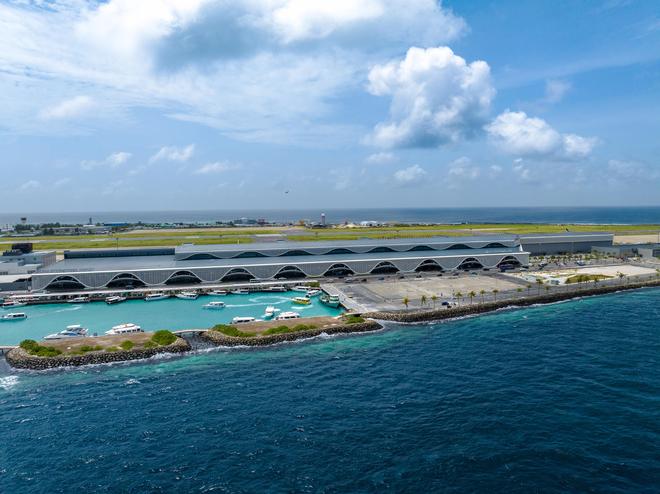The swanky, new terminal includes 47 check-in counters, six self-service kiosks, 20 departure immigration counters, six boarding gates, and 12 aerobridges, and aims to serve 7.5 million passengers annually, or over thrice its current capacity
| Photo Credit:
abeedh
“A pillar of economic independence” — that is what Maldivian President Mohamed Muizzu called the new terminal at the Velana International Airport near Male, while inaugurating it on June 26,2025, the country’s 60th Independence day.
The launch ceremony was spectacular, with synchronised fireworks lighting up the sky – a fete that put the Maldives in the Guinness Book of World Records.
Addressing a large crowd, President Muizzu spelled out the aspiration of the country of 4 lakh people, currently grappling with high external debt — it exceeded $8 billion 2024 — and its inevitable fiscal consequences. His administration is trying to tighten its fiscal policy, alongside a full-throttle push to tourism, the country’s biggest foreign exchange earner that contributes 21 per cent to the GDP. The airport’s new terminal will drive growth, particularly in tourism, as well as the broader economy, Muizzu noted optimistically as the Indian Ocean archipelago grapples with twin deficits and a daunting debt repayment schedule this year and next.
The scenic country’s policy makers have put all eggs in the tourism basket, and are fervently hoping that the new terminal will make a difference. Not just Maldivian policy makers, even international financial institutions see the new terminal as a likely game-changer. In its Maldives update in April 2025, the World Bank noted that the new terminal’s completion would enable higher tourist arrivals, and lead to a projected economic growth of “5.2 per cent on average over the medium term. “Thanks to the Maldives’ strong tourism base, growth has held up well…the opening of airport terminal expansion would ease supply-side bottleneck for tourism and help sustain growth momentum,” an IMF said at the end of its February 2025 mission.

The scenic country’s policy makers have put all eggs in the tourism basket, and are fervently hoping that the new terminal will make a difference
For Maldivians, the airport terminal symbolises a long-held dream that has finally come true, after a decade marked by key political shifts and considerable economic strain stemming from high foreign debt, including to China and India.
“For over 20 years now, there has been talk in the Maldives about not having the right gateway. As a sought-after destination drawing affluent tourists, it is important to make a good first impression, and we finally have that now,” said Abdulla Ghiyas, Chairperson of the Maldives Marketing and Public Relations Corporation (MMPRC) or ‘Visit Maldives’ as the State-owned tourism promotion authority brands itself.
The swanky, new terminal includes 47 check-in counters, six self-service kiosks, 20 departure immigration counters, six boarding gates, and 12 aerobridges, and aims to serve 7.5 million passengers annually, or over thrice its current capacity. The largest structure to be built in the Maldives, the new terminal’s design showcases the Maldives’s identity through traditional motifs and wave patterns.
According to officials of the Maldives Airport Company Ltd (MACL) and Tourism department, the facility has come up at a cost of $585 million, that the Muizzu administration raised through loans from the Saudi Fund for Development, the OPEC Fund for International Development, the Kuwait Fund for Arab Economic Development, and the Abu Dhabi Fund for Development, in addition to allocations in the national budget. Detractors contend that the airport terminal has come up after nearly a decade after it was envisaged, with three successive leaders attempting to take the project forward, while incurring higher costs.
The terminal came into focus initially in the context of former President Abdulla Yameen abruptly terminating Indian infrastructure conglomerate GMR’s contract to run the main airport of Maldives. The idea of a new terminal also fit into President Yameen’s plans to expand the country’s main airport with a $800-million Chinese loan, an initiative he launched in 2016.
Despite sharp tensions among various political camps that make up the Maldives’s ruling establishment, everyone agrees that the country desperately needed the new terminal, and see its recent launch is important for its economy.
However, while admitting that it is “crucial” for the Maldivian economy that the new airport terminal is fully operational soon, chairperson of the opposition Maldivian Democratic Party Fayyaz Ismail described it a “debt-laden, cost-overrun project” with years of delay. “If the initial airport project awarded in 2010 had not been terminated on spurious grounds, it would have been opened in 2014, and our economy would have tripled by now without any debt to the nation. The debt related to the airport is nearly a third of our foreign debt,” he told The Hindu, referring to the contract awarded to GMR in 2010, during former President Mohamed Nasheed’s time in office.
The termination of the project, Ismail said, was the “most stupid thing” a government did in recent times, blaming the country’s current debt burden squarely on the move. President Yameen’s 2012 decision reflected his hostility towards India, that would only grow in the following years, especially when he sought to challenge his successor Ibrahim Mohamed Solih’s administration that pursued an “India first” foreign policy. As Yameen stepped up his “India Out” campaign, it eventually became a useful poll plank for incumbent President Muizzu, who rose to office in 2023.
President Muizzu’s first year in office saw a persisting strain in Maldives-India ties. But a year later, the relationship was reset, and evident in Prime Minister Narendra Modi’s State visit to the island nation last month, on the occasion of its 60th anniversary of Independence. India’s $400 million currency swap in 2024, and subsequent economic assistance was “pivotal” for the country’s economic stability, President Muizzu acknowledged during Modi’s visit.
Meanwhile, Maldives tourism officials said they hope Indian tourists will return to the island in large numbers, putting behind past tensions that sparked a loud “Boycott Maldives” campaign in India. The call that went viral on Indian social media early in 2024, led to a sharp decline in numbers last year, but things are looking up now, according to Tourism sector representatives in the Maldives.
Authorities have set an ambitious $5 billion target for tourism revenue this year. A 9 per cent uptick in arrivals has been recorded from January to June 2025, compared to the same period last year. The Maldives Monetary Authority, too, pointed “robust arrivals” from China, the country’s top source market, and the other markets in Europe.
Those in India’s tourism industry see Modi’s recent visit “generating optimism” about increasing Indian tourist arrivals, as the Maldives aims to attract 300,000 Indian visitors in 2025. “The Maldives government has been working to attract Indian tourists through various initiatives, including improving air connectivity, targeted marketing, and appointing actor Katrina Kaif as its brand ambassador,” said Jyoti Mayal, Chairperson, Tourism & Hospitality Skill Council and the former President of the Travel Agents Association of India.
India currently ranks six among the Maldives’s source markets. From January to June this year, a total of 66,501 Indian tourists visited the country. Through roadshows and other promotional efforts, including through young Maldivians’ interest in Bollywood, authorities in Male are keen to build bridges. “I believe numbers will come back, though it may take a bit longer, as the sentiments of the traveller have been hurt,” Mayal added.
(The writer was invited by Visit Maldives for the inauguration of the new terminal at Velana International Airport)
Published on August 9, 2025
Source link
[ad_3]
[ad_4]

